 |
Details Spectacle blinds Spades and Ring spacers |
Spectacle blinds
Spectacle Blinds are generally applied to permanently separating pipesystems, or just to connect
with each other. A Spectacle Blind is a steel plate cut into two discs of a certain thickness.
The two discs are attached to each other by section of steel similar to the nose piece of a pair
of glasses. One of the discs is a solid plate, and the other is a ring, whose inside diameter is
equal to that of a flange.
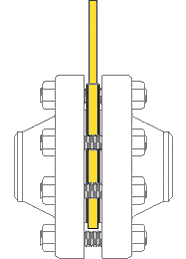
Spectacle blind
between two flanges
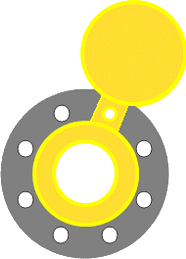
Spectacle blind
open position
Spectacle Blinds be applied in systems, which regularly need to be separated from other installations. Normally, a Spectacle Blind is mounted in the "open" position so that flow through the pipe is possible. If the Spectacle Blind in the "close" position is rotated, the pipe is blanked off and no flow is possible.
Maintenance on a pipesystem can be a reason to rotate the spectacle in the "close" position. This run will take place through the hole, that is drilled in the connection piece. By loosening of all bolts, and partial removal of their, the Spectacle Blind can be rotated. After replacing the gaskets (new gaskets are to recommend), the bolts can be re-assembled and tightened.
Spades and Ring Spacers
Spades
Spades and Ring Spacers are basically the same as Spectacle Blinds, except that both are not attached to each other.
Spades and Spacers be applied in systems where maintenance is often not necessary, or in applications with large pipe sizes. Depending on the flange size and the Pressure Class, Spades can weigh hundreds of pounds. To prevent unnecessary weight to a flange connections, usually will be chosen not for a Spectacle Blind, but for 2 separate parts.
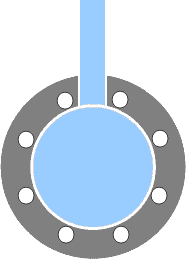
Spade closed position
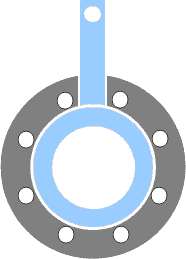
Ring Spacer open position
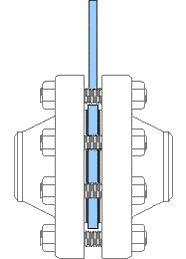
Spade between flanges
Ring Spacer
So as for the Spectacle Blind already described, maintenance on a pipesystem can be a reason to temporarily replace a Ring Spacer for a Spade. By loosening of all bolts, and half of the bolts temporarily remove, the Spade or Spacer can be placed. After replacing the gaskets (new gaskets are to recommend), the bolts can be re-assembled and tightened.
A small problem is that we basically can not see, or a Spade or a Spacer mounted between the flanges. Therefore the handles are often specially marked, or both have a different design; a customer often provides its own specification.
What should never lack is, that in the handle, the diameter and the Pressure Class of a Spade or Spacer is engraved; this applies also for the Spectacle Blind.
Surfaces - Dimensions - Material
The sealing surfaces of a Spectacle Blind, Spade or Ring Spacer are usually conducted in accordance with the Face Finish from the flange. The diameter always is slightly larger than the Raised Face of a flange; by a correct assembly, the bolts are just not touched by the Blind or Spacer.
The diameter of them, is depending on the flange size, and the thickness from the Pressure Class
of a flange.
Dimensions from Spectacle Blinds, Spades and Ring Spacers, you will find in the main Menu "Flanges"
ASME B16.48 covers pressure-temperature ratings, materials, dimensions, dimensional tolerances, marking, and testing for operating line blanks in sizes NPS 1/2 - NPS 24 for installation between ASME B16.5 flanges in the 150, 300, 600, 900, 1500, and 2500 Pressure Classes.
Spectacle Blinds, Spades and Ring Spacers should be made from a plate or forging specification, approved for use by ASME B31.3, of essentially the same chemical composition as the mating flanges and piping involved.
Remark(s) of the Author...
Is it necessary to use Spectacle Blinds?
- I think not, because they are ineffective in many practice situations.
On paper it seems simple, remove some bolts, turning the spade and mount the flange back. In practice is certainly not...
I am in favor of two separate flanges (ring and solid plate)
Raised Face Joint Blanks
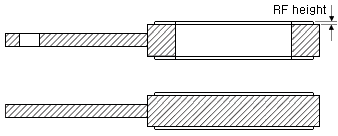
ASME B16.48 says..The gasket seating surface finish and dimensions for raised
face line blanks shall be in accordance with ASME B16.5. A raised face may be specified at
the option of the purchaser.
A Raised Face would add machining time and complexity so the price would be higher. Call this the
Bugatti or Rolls Royce of the line blind world.
Personally, I have seen that version once or twice somewhere. The version without Raised Face is
the default and is used everywhere.
What is the formula to calculate the thickness of a spacer?
Sometimes it is necessary to use a thinner spacer, because a spacer with a standard thickness often can not be mounted between two flanges...Think of a pressure test in a "Life Plant" where a spacer should be installed between two flanges.
As a rule of thumb the following formula can be used to calculate the thickness in millimeters..
- Pressure (barg) multiply by diameter (inches) divided by 10
- Pressure.. the highest pressure that the system can achieve
- Diameter.. the size of the spacer in inches
- Example.. 8 x 12 / 10 - thickness of spacer = 9.6 mm
Note.. always try to apply spacer thicknesses in accordance with ASME B16.5.